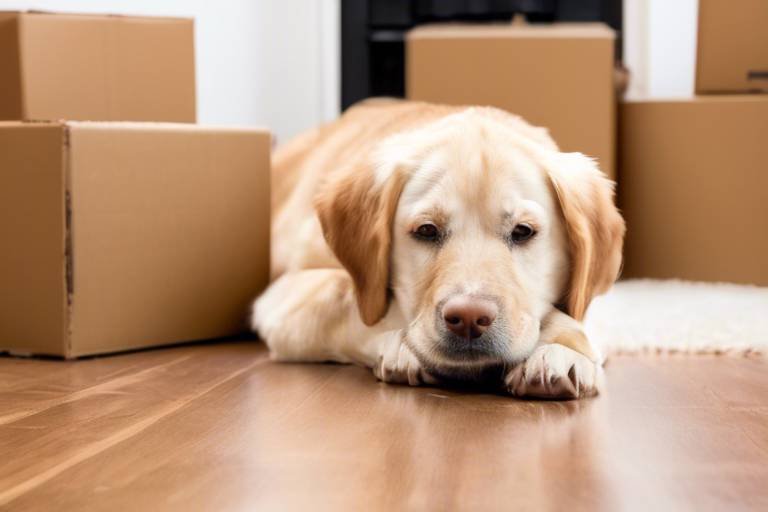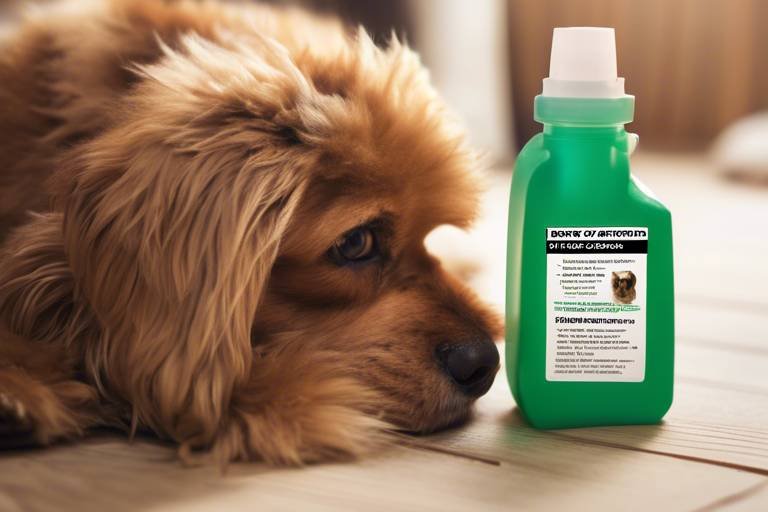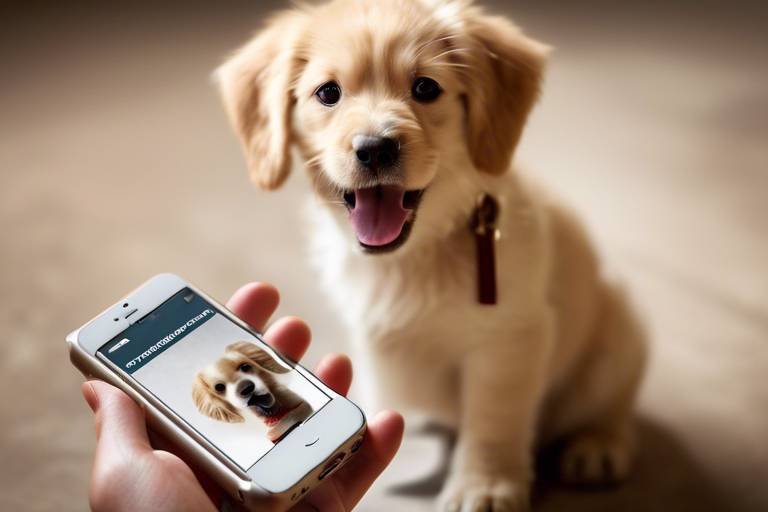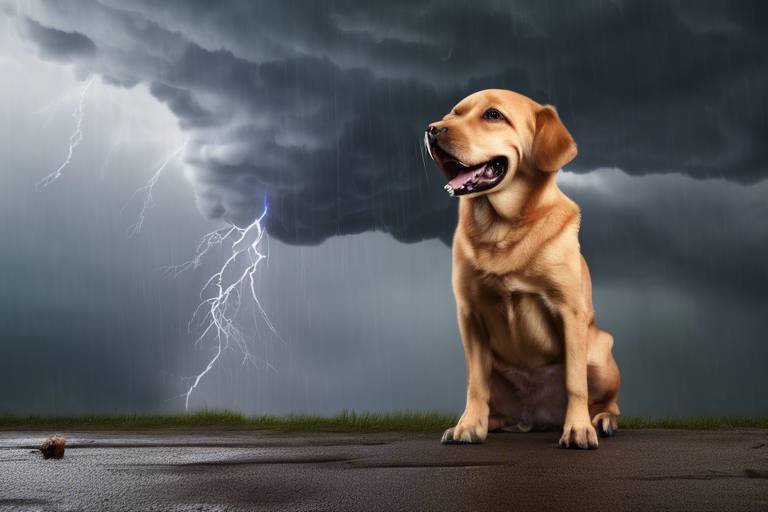How to Prevent Pets from Escaping During Emergencies
In this article, we will explore effective strategies to keep your pets safe and secure during emergencies, ensuring they remain calm and contained when it matters most. Emergencies can strike without warning, and when they do, our furry friends can become anxious and disoriented. This is why it’s crucial to have a plan in place to prevent them from escaping. Just like a ship needs a sturdy anchor in a storm, your pets need a reliable safety net during chaotic situations. By understanding their behavior, creating a safe space, and having the right identification, you can significantly reduce the chances of your pets getting lost or harmed during an emergency.
Recognizing how pets react in stressful situations is crucial. Every pet has its own unique personality, but many share common behavioral patterns when faced with fear or anxiety. For instance, dogs might bark incessantly or try to hide, while cats may seek high places or attempt to bolt for the door. These instinctual reactions stem from their survival instincts, often leading them to escape when they feel threatened. Understanding these behaviors can help you prepare better. Consider this: if you know your dog tends to run when scared, you can take proactive measures to keep them secure. It’s like knowing the tide will rise; you wouldn’t leave your boat unmoored, right?
Designing a secure area for your pets can minimize the risk of escape. Picture this safe space as a cozy bunker where your pets can feel protected and calm amidst the chaos. It should be a familiar environment filled with their favorite things, reducing anxiety and promoting a sense of security. When creating this safe haven, consider the following:
Selecting an appropriate location for your pet's safe space is essential. Ideally, this area should be away from windows and doors where outside noise and movement can trigger anxiety. A quiet room or a basement can serve as an excellent choice, providing a sense of security. Think of it as building a fortress; the more secure the location, the less likely your pets will feel the urge to escape. Make sure it’s easily accessible to you, so you can check on them and provide comfort when needed.
Using physical barriers such as gates and crates can help contain pets during emergencies. These tools act like a protective wall, keeping your pets contained and safe. When choosing barriers, ensure they are sturdy and tall enough to prevent jumps or climbs. A well-placed gate can keep your dog in a secure area, while a crate can provide a cozy den-like atmosphere for smaller pets. Remember, it’s not just about containment; it’s about creating a sense of safety. Equip your barriers with familiar scents, like a blanket or a piece of your clothing, to help your pets feel more at ease.
Including familiar items like blankets or toys can help soothe pets. Just like a child might cling to a favorite stuffed animal during a storm, your pets will benefit from having their cherished items nearby. These comfort items can serve as a reminder of home, helping to alleviate stress. In the midst of chaos, these small touches can make a world of difference. Consider creating a “comfort kit” that includes their favorite toys, a soft blanket, and even a piece of your clothing. This will not only provide physical comfort but emotional reassurance as well.
Training your pets to respond to commands can be beneficial during emergencies. Think of it as teaching them a life skill; the better they understand your commands, the more likely they are to remain calm and collected when the unexpected occurs. Simple commands like “stay” or “come” can be invaluable. Consistent training sessions, even when things are calm, will prepare them for when chaos strikes. Just like a fire drill prepares you for the real thing, training can help your pets respond appropriately in emergencies. Plus, it strengthens the bond between you and your pet, creating a trusting relationship that can ease their fears.
Ensuring your pets are properly identified is vital for their safety. In the event of an emergency, having up-to-date tags, collars, and microchipping can be the difference between a lost pet and a quick reunion. Think of identification as your pet's safety net; it’s their ticket home if they wander off. Microchipping is a simple procedure that can provide lifelong security, ensuring your pet can always be identified.
Regularly updating your pet's identification information is crucial. Just like you wouldn’t want outdated contact information, your pets need to have current details as well. Make sure their tags are visible and include your phone number. Consider adding an additional emergency contact, just in case you’re unreachable. This small step can make a big difference in reuniting you with your pet.
Establishing an emergency contact plan can aid in locating lost pets. Think of it as your pet’s safety network; it should include family members, friends, and local shelters. Sharing this plan with everyone involved ensures that if your pet goes missing, there’s a coordinated effort to find them. Create a simple document outlining who to contact and what steps to take. This proactive approach can save precious time during a crisis.
Having an emergency kit specifically for pets is essential. Just like you pack a bag for yourself in case of an emergency, your pets need their own supplies too. Think of it as a lifeline; having everything ready can make stressful situations a little easier. Your pet’s emergency kit should include food, water, medications, and any other essentials they might need.
Identifying essential supplies for your pet's emergency kit is crucial. Here’s a comprehensive list of items that should be included to ensure your pet's well-being:
- Food and water (enough for at least three days)
- Medications and medical records
- First-aid kit
- Leash and harness
- Comfort items (toys, blankets)
- Identification tags and microchip information
Regularly updating your pet's emergency kit ensures it remains relevant. Just like you check your own supplies, make it a habit to review your pet’s kit every few months. Check expiration dates on food and medications, and replenish any used items. This simple act can ensure you’re always prepared, no matter what life throws your way.
Q: What should I do if my pet escapes during an emergency?
A: Stay calm and try to locate your pet immediately. Use familiar commands and call their name. If they don’t respond, enlist the help of neighbors and local shelters.
Q: How can I train my pet to stay calm during emergencies?
A: Regular training sessions focusing on commands like “stay” and “come” can help. Additionally, desensitizing them to loud noises and sudden movements can reduce anxiety.
Q: Is microchipping painful for pets?
A: Microchipping is a quick procedure, similar to getting a vaccination. Most pets experience minimal discomfort, and the long-term benefits far outweigh the brief moment of pain.
Q: How often should I update my pet's identification tags?
A: You should update your pet's identification tags whenever there’s a change in your contact information or at least once a year to ensure accuracy.

Understanding Pet Behavior
When it comes to our furry friends, understanding their behavior during stressful situations is crucial for their safety and well-being. Pets, much like humans, can experience anxiety and fear during emergencies, which may lead to unexpected behaviors, including attempts to escape. Have you ever noticed how your dog reacts to loud noises like thunderstorms or fireworks? Their instinct is to seek safety, often resulting in frantic behavior. In this section, we will delve into the common behavioral patterns and instincts that may lead to escapes during emergencies, ensuring you are well-equipped to handle such situations.
Firstly, it’s important to recognize that pets have a natural fight-or-flight response. When faced with danger, their instinct may push them to flee, which can be particularly alarming during an emergency. For instance, a cat might dash under the nearest piece of furniture, while a dog may try to bolt out the door. Understanding these instincts can help you anticipate your pet's behavior and take proactive measures to keep them secure. Think of it this way: just as we might react impulsively during a crisis, our pets do the same, and they rely on us to provide a sense of safety.
Another key aspect to consider is the unique personality of your pet. Some pets are naturally more anxious than others. For example, a shy dog may become overly stressed in chaotic situations, while a more confident cat might handle the same scenario with ease. To better understand your pet’s behavior, observe them in various situations. Take note of their reactions to different stimuli, such as loud noises, unfamiliar people, or sudden changes in their environment. This awareness can help you to create a tailored emergency plan that caters specifically to your pet's needs.
In addition to instinctual behaviors, environmental factors also play a significant role in how pets react during emergencies. For instance, if your home is filled with unfamiliar sounds and movements, it may trigger a sense of panic in your pet. To mitigate this, consider creating a calm atmosphere during emergencies. Use soothing music or essential oils known for their calming properties. It’s like creating a cozy haven in the midst of chaos. By doing so, you can help your pets feel more secure and less likely to attempt an escape.
Lastly, it’s beneficial to familiarize yourself with specific signs of stress in pets. These can include:
- Excessive barking or meowing
- Pacing or restlessness
- Hiding or seeking isolation
- Destructive behaviors, such as chewing or scratching
Recognizing these signs early can help you intervene before your pet feels the need to escape. Just like us, pets communicate their feelings through behavior. By tuning into these signals, you can take steps to reassure them and keep them safe during emergencies.
In summary, understanding pet behavior is a vital component in preventing escapes during emergencies. By recognizing instinctual reactions, considering individual personalities, managing environmental factors, and identifying stress signals, you can create a comprehensive plan that ensures your pets remain calm and secure when it matters most. Remember, your pets look to you for guidance and comfort, especially in times of crisis.

Creating a Safe Space
Creating a safe space for your pets during emergencies is not just a precaution; it's a necessity. Imagine being in a chaotic situation where loud noises and unfamiliar scents surround you. Now, think about your furry friend experiencing the same anxiety. By establishing a designated area where they feel secure, you can significantly reduce their stress levels and the likelihood of them attempting to escape. This space should be a haven, a place where they can retreat and feel protected amidst the storm of commotion that emergencies often bring.
When designing this safe space, consider a few key elements that will make it both comfortable and secure. First, location matters. You want to choose a spot in your home that is away from the hustle and bustle of the main living areas. A quiet corner in a bedroom or a cozy nook in a less-trafficked area can work wonders. Ideally, this space should be familiar to your pet, as it can help them feel more at ease. Think about where they usually like to hang out—perhaps it’s under a table or in a specific room. Use these insights to guide your choice.
Finding the best location is only half the battle; the next step is to ensure it’s equipped with everything your pet might need. Consider the following factors:
- Noise Level: Pick a spot that is as far away from loud sounds, like sirens or thunderstorms, as possible.
- Access to Comfort: Make sure they can easily access their safe space without obstacles.
- Visibility: If your pet feels more secure when they can see you, position their safe space in a way that allows them to keep an eye on your movements.
Now, let’s talk about the physical barriers that can help keep your pet contained. Using gates or crates can be an effective way to ensure they don’t wander off in a panic. However, it’s important to choose barriers that are appropriate for your pet's size and behavior. For instance, a small dog might be easily contained by a simple gate, while a larger or more energetic breed may require a sturdier, more secure crate. The goal is to create a physical boundary that feels safe yet doesn’t feel like a prison.
When setting up these barriers, think about how your pet interacts with them. Some pets may feel anxious in confined spaces, so it’s crucial to introduce them to their crates or gates well before an emergency arises. Make these areas inviting by adding their favorite blanket or a toy. This way, they’ll associate the space with comfort rather than confinement. Remember, the aim is to create a safe haven where they can retreat when the world outside feels overwhelming.
Speaking of comfort, don’t underestimate the power of familiar items. Including a few of your pet's favorite belongings can significantly enhance their sense of security. A soft blanket, a beloved toy, or even an item of your clothing can provide solace amid chaos. These comfort items can act as a grounding mechanism, helping your pet feel less alone and more at ease. In times of distress, these little tokens of familiarity can make a world of difference.
In summary, creating a safe space for your pets during emergencies is about more than just physical containment; it’s about fostering an environment where they can feel secure and calm. By choosing the right location, using effective barriers, and incorporating comfort items, you can help your beloved companions navigate through the storm with a little less worry. Remember, in the eyes of your pet, you are their protector, and providing them with a safe haven is one of the best ways to show your love.
Q: How can I help my pet adjust to their safe space?
A: Gradually introduce them to the area during calm times. Use treats and positive reinforcement to create a positive association.
Q: What should I do if my pet refuses to go into their safe space?
A: Try making the space more inviting with their favorite toys or blankets. You can also spend time with them in the area to help them feel more comfortable.
Q: How often should I check on my pet during an emergency?
A: It's essential to check on them regularly, especially if they seem anxious. Your presence can be very reassuring.
Choosing the Right Location
When it comes to keeping your furry friends safe during emergencies, for their safe space can make all the difference. Think of this space as a little sanctuary where they can feel secure and calm amidst the chaos. Ideally, this area should be away from windows and doors to minimize the noise and stress that can come from outside disturbances. A quiet corner of your home, perhaps in a bedroom or a cozy den, can provide that much-needed comfort.
Consider the layout of your home and how your pets typically behave. Do they seek out small, enclosed spaces when they're scared? If so, a closet or a bathroom could serve as an ideal refuge. On the other hand, if your pets are more social and prefer to be around family members, a living room corner with their favorite blanket and toys might be the best option. It's all about understanding their preferences and instincts.
Another factor to consider is the accessibility of the location. During emergencies, you want to ensure that you can easily guide your pets to their safe space without adding to their anxiety. This means keeping the path clear and free from obstacles. If your pet is prone to panic, having a designated spot that is easy to reach can help you act swiftly, reducing the chances of them escaping out of fear.
Lastly, don't forget to evaluate the environment of the chosen location. Is it a place where they can feel secure and undisturbed? Make sure it’s a spot where they won’t be easily startled by loud noises or sudden movements. You might also want to consider adding some of their favorite items, such as a familiar blanket or a beloved toy, to make the space even more inviting. A little bit of familiarity can go a long way in easing their stress during a crisis.
In summary, choosing the right location for your pets during emergencies involves understanding their behavior, ensuring accessibility, and creating a comforting environment. By paying careful attention to these factors, you can significantly reduce your pets' anxiety levels and help keep them secure when it matters most.
Using Barriers Effectively
When it comes to keeping your pets safe during emergencies, can make all the difference. Think of barriers as the first line of defense against chaos. Just like a well-built fence keeps a curious dog from wandering off, barriers such as gates, crates, and playpens can help ensure your pets stay contained and calm when the world around them gets overwhelming. But how do you choose the right barriers, and how do you use them to their fullest potential?
First things first, not all barriers are created equal. You’ll want to consider your pet's size, temperament, and escape artist skills. For instance, a sturdy gate might work wonders for a small dog or a cat, but a large, energetic breed may need something more robust. A heavy-duty crate could be a lifesaver in a crisis, providing a secure space for your pet to retreat to when things get hectic. It's essential to select barriers that are not only strong but also comfortable for your pet. They should feel safe, not trapped.
Once you have the right barriers, placement is key. You want to position them in areas where your pets are likely to be during an emergency. For example, if a storm is brewing, you might want to set up a gate in the hallway leading to a safe room. This way, you can easily guide your pets to safety without them darting off in panic. Additionally, consider using barriers in conjunction with other safety measures, like keeping windows and doors closed to prevent escape routes.
Another important aspect of using barriers effectively is ensuring your pets are familiar with them. Gradually introducing your pets to these barriers during calm moments can help them associate them with safety rather than confinement. You might want to reward them with treats or praise whenever they enter their crate or stay behind a gate. This positive reinforcement can make a world of difference when an emergency strikes.
Lastly, always keep in mind that barriers are not foolproof. Regularly check for any weaknesses or potential escape routes. Pets can be surprisingly resourceful, and you wouldn't want to find out too late that your barrier isn't as secure as you thought. So, whether it’s a gate that’s slightly ajar or a crate that’s lost its latch, staying vigilant is crucial.
In summary, using barriers effectively is about choosing the right tools, placing them wisely, and ensuring your pets feel comfortable and safe. By doing so, you’ll not only keep your pets contained during emergencies but also help them remain calm and collected, allowing you to focus on managing the situation without worrying about their safety.
- What types of barriers are best for dogs? Heavy-duty gates and sturdy crates are ideal for dogs, especially larger breeds that may try to escape.
- Can I use barriers for cats? Yes! Cat playpens and smaller gates can help keep cats contained and safe during emergencies.
- How can I train my pet to accept barriers? Gradually introduce them to the barriers with positive reinforcement, such as treats and praise.
- What if my pet is anxious around barriers? Create a positive association by rewarding them when they are calm and near the barriers.
Comfort Items for Pets
When it comes to ensuring your furry friends feel safe and secure during emergencies, comfort items play a pivotal role. Just like humans, pets can experience anxiety and stress when faced with unexpected situations. Imagine being in a loud, chaotic environment without your favorite blanket or toy; it’s enough to make anyone feel uneasy! By providing your pets with familiar items, you can significantly reduce their anxiety levels and help them cope more effectively.
So, what exactly qualifies as a comfort item? Well, it can be anything from their beloved blanket that smells like home to a favorite toy that brings them joy. These items serve as a reminder of their safe space and can help ground them during tumultuous times. For instance, a soft, cozy blanket can provide warmth and a sense of security, while a squeaky toy can distract them from the chaos around them. It’s all about creating an environment that feels familiar and safe.
In addition to blankets and toys, consider including items that engage their senses. For example, a pet's bed or a piece of your clothing can offer comfort through scent. The familiar smell of a loved one can be incredibly soothing. You might also want to think about including a calming spray or pheromone diffuser in their safe space. These products can help create a tranquil atmosphere, further easing your pet's anxiety.
It’s essential to remember that not all pets will respond the same way to comfort items. Some may find solace in a quiet corner with their blanket, while others might prefer the company of their favorite toy. Observing your pet’s behavior can provide valuable insights into what comforts them most. Additionally, introducing these items well before any emergency occurs can help your pet associate them with safety and calmness.
To sum it up, having the right comfort items can make a world of difference for your pets during emergencies. By providing them with familiar scents and textures, you’re not just helping them cope; you’re also reinforcing the bond you share. Remember, a calm pet is a happy pet, and a little preparation can go a long way in ensuring their well-being when it matters most.
- What are the best comfort items for pets? The best comfort items typically include blankets, toys, and items that carry familiar scents, like your clothing.
- How can I help my pet feel more secure during an emergency? Providing comfort items, creating a safe space, and using calming sprays or pheromones can help your pet feel more secure.
- Should I introduce comfort items before an emergency? Yes, introducing comfort items before an emergency helps your pet associate them with safety and calmness.
- Can I use calming products for my pet? Yes, calming sprays and pheromone diffusers can be beneficial in creating a tranquil environment for your pet.
Training Your Pets
Training your pets is not just about teaching them tricks; it’s a vital part of ensuring their safety during emergencies. Imagine this: you’re in the middle of a crisis, and your pet is scared, confused, and potentially trying to escape. Having a well-trained pet can make all the difference. It’s like having a well-oiled machine that responds to your commands, rather than a chaotic whirlwind of fur and panic.
Start with the basics. Teaching your pet simple commands such as “sit,” “stay,” and “come” can be incredibly beneficial. These commands can help you maintain control over your pet during stressful situations. For instance, if there’s a loud noise that startles them, a quick “stay” can keep them from bolting out the door. Consistency is key here—practice regularly and reward your pets to reinforce good behavior.
It’s also essential to acclimate your pets to different environments and situations. You can do this by gradually exposing them to various sounds, smells, and sights. For example, play recordings of thunder or sirens at a low volume while giving them treats and praise. This method, known as desensitization, can help reduce fear and anxiety when they encounter real-life emergencies.
Moreover, consider incorporating positive reinforcement into your training routine. This approach not only builds trust between you and your pet but also encourages them to respond positively in stressful situations. Use treats, praise, or playtime as rewards. The more your pet associates your commands with positive outcomes, the more likely they are to respond when it matters most.
In addition to basic commands, practicing emergency drills can be beneficial. Just like we prepare for emergencies ourselves, involving your pets in these drills can help them understand what to do during a crisis. For example, practice getting them to their safe space quickly and calmly. Make it a fun activity, so they associate it with positive experiences rather than stress.
Lastly, remember that patience is crucial. Every pet learns at their own pace, and some may need more time than others. Celebrate small victories and be persistent. With time and effort, you’ll build a strong foundation that ensures your pet remains calm and controlled during emergencies.
- How long does it take to train my pet? The time it takes to train a pet varies based on the animal's age, breed, and individual personality. Consistent short training sessions can yield results in just a few weeks.
- Can I train an older pet? Absolutely! Older pets can learn new commands; it may just take a bit more patience and repetition.
- What if my pet doesn’t respond to commands? If your pet struggles with commands, consider consulting a professional trainer who can offer personalized strategies.

Identification and Microchipping
When it comes to keeping your furry friends safe, identification is paramount. In the chaos of an emergency, pets can easily become frightened and disoriented, leading them to flee from their homes. This is where proper identification plays a crucial role in reuniting you with your beloved companions. A simple collar with an ID tag can make all the difference, but it’s not always foolproof. Tags can fall off or get lost, which is why microchipping your pet is highly recommended. Microchips are tiny devices that are implanted under your pet's skin, containing a unique identification number linked to your contact information. This means that even if your pet manages to escape, a quick scan at a veterinary clinic or animal shelter can help reunite you.
Moreover, it’s important to remember that microchipping is not a substitute for a collar and ID tag. While a microchip is a permanent form of identification, it relies on someone finding your pet and taking them to a vet or shelter to be scanned. Therefore, having both forms of identification can significantly increase the chances of a safe return. Imagine the peace of mind you’ll have knowing that your pet has multiple ways to be identified if the worst happens!
In addition to microchipping, keeping your pet’s identification updated is crucial. It’s easy to overlook, but ensuring that your contact information is current on both the collar tag and the microchip registry can save you a lot of heartache. Regularly check your pet's tags and make sure they reflect your latest phone number and address. It's a small task that can make a big difference. After all, you wouldn’t want your lost pet to end up in a shelter without a way to contact you!
To further emphasize the importance of identification, let’s take a look at some statistics:
| Statistic | Percentage |
|---|---|
| Pets that are microchipped and returned to their owners | 74% |
| Pets without identification that are returned | 15% |
As you can see, the odds are definitely in favor of microchipped pets! But what if your pet does go missing? Having an emergency contact plan in place can also be a lifesaver. This plan should include family members, friends, and local shelters that can help search for your lost pet. Share this plan with everyone involved, so they know what to do in case of an emergency. Remember, the more prepared you are, the easier it will be to navigate through crises.
In conclusion, investing in proper identification for your pets is a small price to pay for the safety and security of your furry family members. By ensuring they are microchipped and that their tags are up to date, you can rest easy knowing you’ve done everything possible to protect them during emergencies.
- How does microchipping work? Microchipping involves implanting a small chip under your pet's skin, which contains a unique identification number that can be scanned by a vet or shelter.
- Is microchipping painful for pets? The procedure is similar to a vaccination and is usually quick and causes minimal discomfort.
- Can my pet be tracked with a microchip? No, microchips do not use GPS technology; they only provide identification when scanned.
- How often should I update my pet's information? You should update your pet's information whenever you change your address or phone number.
Updating Identification Information
One of the most critical steps in ensuring your pet's safety during emergencies is to keep their identification information up to date. Imagine your pet getting lost in a chaotic situation, and the only way to reunite with them is through their ID tags or microchip. If the information on these identifiers is outdated, the chances of a happy reunion diminish significantly. Therefore, regular updates are not just a precaution; they are a necessity.
Start by routinely checking your pet's collar and tags. Make sure they clearly display your current contact information, including your phone number and address. If you've recently moved or changed your phone number, it's essential to update this information immediately. You wouldn't want a well-meaning stranger trying to return your beloved pet to an old address, would you?
In addition to tags, consider the importance of microchipping. Microchips are a permanent form of identification that can provide peace of mind. However, it's not enough to just have your pet microchipped; you must also ensure that the chip is registered with accurate and current information. Many pet owners forget to update their details with the microchip company after a move or change in phone number. This oversight can lead to heartbreaking scenarios where lost pets cannot be traced back to their owners.
To help you keep track of what needs updating, here’s a simple checklist:
- Check collar tags for wear and readability.
- Update contact information on tags immediately after a move or change.
- Verify that your microchip registration is current and accurate.
- Consider adding a secondary contact, like a family member or friend, who can be reached in case you are unavailable.
Moreover, it’s a good idea to keep a digital record of your pet's identification information. This could be a simple note on your phone or a dedicated app that stores all relevant details, including microchip numbers, vet contact information, and emergency contacts. This way, you can quickly access the information you need in a crisis.
In conclusion, regularly updating your pet's identification information is a straightforward yet vital task that can make all the difference in an emergency. By taking these proactive steps, you can ensure that your furry friend has the best chance of being returned to you safely, no matter the circumstances.
Emergency Contact Plans
Establishing an emergency contact plan is a crucial step in ensuring your pets' safety during a crisis. When chaos strikes, having a well-thought-out plan can make all the difference in quickly locating your furry friends. Imagine the panic of searching for a lost pet in the midst of an emergency—it's a heart-wrenching scenario that can be avoided with some preparation.
Your emergency contact plan should include a list of trusted individuals who can help in case you are unable to care for your pets. This could be family members, friends, or neighbors who are familiar with your pets and can assist in their care or help in locating them if they go missing. Make sure to communicate with these individuals about your plan and ensure they are willing to participate. It’s like having a safety net; you never know when you might need it!
Additionally, consider including local shelters and veterinary clinics in your contact plan. In the event of an emergency, these places can be invaluable resources for finding lost pets or providing temporary care. Having their contact information readily available can save precious time. You might want to create a simple table to keep track of all necessary contacts:
| Contact Name | Relationship | Phone Number | Alternate Contact Method |
|---|---|---|---|
| John Doe | Neighbor | (123) 456-7890 | Email: johndoe@example.com |
| Jane Smith | Family | (098) 765-4321 | Text: (098) 765-4321 |
| Local Animal Shelter | Resource | (555) 123-4567 | Website: www.localshelter.org |
It's essential to keep this information updated, especially if there are changes in your contacts or their availability. Regularly review your emergency contact plan and make adjustments as necessary. Also, consider creating a physical copy and placing it in a visible location, such as on your refrigerator or inside your emergency kit. This way, if you need help quickly, you won’t have to scramble to find the info.
Lastly, don’t forget to discuss your plan with all household members. Everyone should know what to do and who to contact in case of an emergency. This shared knowledge can significantly reduce confusion and stress during a crisis. Think of it as a team effort—everyone plays a role in keeping your pets safe!
- What should I include in my emergency contact plan? Make sure to include family members, friends, neighbors, local shelters, and veterinary clinics.
- How often should I update my emergency contact plan? Regularly review and update your plan, especially after any changes in your contacts or their availability.
- What if I can't reach my emergency contacts during an emergency? Having multiple contacts and local resources like shelters can help ensure that someone is available to assist.
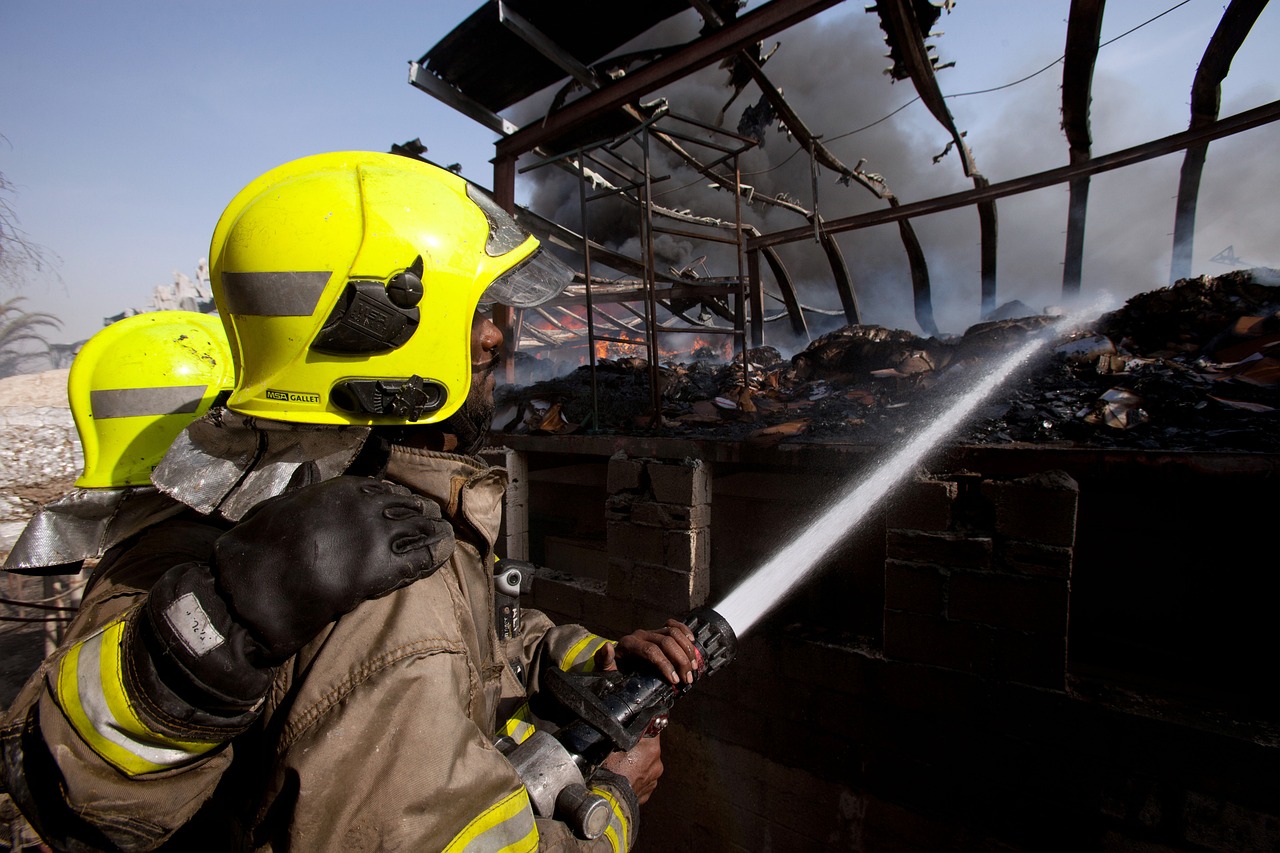
Emergency Kits for Pets
Having an emergency kit specifically designed for your pets is not just a good idea; it’s a necessity. Just like we prepare for unexpected situations in our lives, our furry friends deserve the same level of consideration. Imagine a scenario where you have to evacuate your home due to a natural disaster or an unforeseen emergency. Would you be ready to grab everything your pet needs in a hurry? That's where a well-prepared emergency kit comes into play.
Your pet's emergency kit should be tailored to their specific needs and the types of emergencies you might face. It’s not just about having a few treats and a leash; it’s about ensuring that your pet can stay safe, comfortable, and healthy during a crisis. Think of it as a lifeline that can make all the difference when time is of the essence. Below, we’ll explore some essential supplies to consider for your pet’s emergency kit.
| Essential Item | Description |
|---|---|
| Food and Water | Non-perishable food and enough water for at least 3 days. |
| Medications | Any prescription medications your pet requires, along with a list of dosages. |
| First Aid Kit | A pet-specific first aid kit that includes bandages, antiseptic wipes, and tweezers. |
| Comfort Items | Familiar blankets or toys to help soothe your pet during stressful times. |
| Leash and Carrier | A sturdy leash and a carrier for transporting your pet safely. |
| Identification | Current tags and microchip information in case you get separated. |
Now, while it’s great to have these supplies, it’s equally important to keep your emergency kit updated. Just like you wouldn’t want to rely on expired food or outdated medications for yourself, your pet deserves the same care. Regularly check the contents of your kit—make sure the food hasn’t expired, the medications are still valid, and that you have enough supplies to last for at least three days. You’d be surprised how quickly time flies, and what seemed like a well-stocked kit can turn into a forgotten stash of old items.
In addition to having the right supplies, consider the logistics of your emergency kit. Where will you store it? Ideally, it should be in a readily accessible location, so you can grab it quickly when needed. Perhaps a designated spot near the front door or in a closet that’s easy to reach during an emergency. And don’t forget to inform your family members about the kit’s location and contents. After all, teamwork is key during stressful times!
Lastly, it’s a good idea to practice your emergency plan with your pets. Just like humans, pets can also benefit from a little training. Familiarize them with their carrier and the sound of their leash being clipped on. This can help reduce anxiety when the time comes to evacuate. Remember, a calm pet is less likely to panic and try to escape, which is precisely what you want during an emergency.
Q: How often should I check my pet's emergency kit?
A: It’s advisable to check your pet's emergency kit at least every six months to ensure all supplies are fresh and functional.
Q: What should I do if my pet has special needs?
A: If your pet has special needs, make sure to include any specific items they require, such as special food, medications, or comfort items that help them cope with stress.
Q: Can I use my own first aid kit for my pet?
A: While you can use your own first aid kit, it’s best to have a pet-specific kit that includes items suitable for animals, as their needs can differ significantly from ours.
Essential Supplies
When it comes to keeping your furry friends safe during emergencies, having the right supplies on hand is absolutely crucial. Imagine being in a situation where you need to evacuate quickly or face an unexpected crisis. The last thing you want is to scramble around looking for your pet's essentials. That's why preparing an emergency kit specifically for your pets is a proactive step every pet owner should take. This kit should be tailored to your pet's unique needs and should include a variety of items to ensure their comfort and safety.
First and foremost, you should include food and water. It's a good idea to have at least a three-day supply of your pet's regular food and bottled water. Emergency situations can disrupt access to food stores, so being prepared can make all the difference. Don't forget to pack a manual can opener if you're using canned food! Additionally, having a portable food and water dish is essential for on-the-go feeding.
Next, consider including a first aid kit specifically designed for pets. This should contain items such as antiseptic wipes, gauze pads, adhesive tape, and tweezers. If your pet has any specific medications, be sure to pack those as well. Just like you would for yourself, having a first aid kit can help you address minor injuries or health issues that may arise during stressful situations.
Another important item to include is a leash and harness. In the chaos of an emergency, pets can become anxious and disoriented, making it vital to have a secure way to control them. A sturdy leash will help you keep your pet close and safe while navigating through potentially hazardous environments. If your pet is prone to escaping, consider using a harness instead of a collar, as it provides better control.
Don't forget about comfort items. Familiar toys, blankets, or bedding can help soothe your pet and provide a sense of security during stressful times. Just like we find comfort in our favorite items, pets do too. Including these in their emergency kit can help alleviate anxiety and keep them calm.
Lastly, make sure to include identification documents and a recent photo of your pet. In the unfortunate event that you become separated, having these documents can expedite the process of reuniting with your furry friend. A microchip is also a great addition, as it provides a permanent form of identification that can't be lost or removed.
In summary, your pet's emergency kit should be a well-rounded collection of supplies that prioritize their health, safety, and comfort. Regularly check and update the kit to ensure that everything is in good condition and that none of the items have expired. Remember, being prepared is the best way to keep your pets safe during emergencies!
- What should I include in my pet's emergency kit?
Essential items include food, water, a first aid kit, leash, comfort items, and identification documents. - How often should I update the emergency kit?
Regularly check your kit every few months to replace expired items and ensure that everything is up-to-date. - Can I use human first aid supplies for my pet?
While some human supplies can be used, it's best to have a dedicated pet first aid kit tailored to their needs.
Regular Kit Updates
Keeping your pet's emergency kit updated is not just a good practice; it's a necessity that can make a world of difference in a crisis. Imagine this: you’re in the middle of a chaotic situation, and you reach for your pet’s emergency supplies only to find that the food has expired or the medications are outdated. Panic sets in, and you realize that you could have avoided this stress with a little foresight. To prevent such scenarios, it's essential to regularly check and update the contents of your pet's emergency kit.
First and foremost, you should establish a routine for reviewing your kit. A good rule of thumb is to check it every six months, ideally coinciding with the changing of seasons. This way, you can ensure that all items are still in good condition and that nothing has expired. You might even consider setting a reminder on your phone or marking it on your calendar. After all, consistency is key!
During your review, pay special attention to the following items:
- Food and Water: Check expiration dates and ensure you have enough for at least three days. Consider your pet's dietary needs and any changes that may have occurred.
- Medications: If your pet is on medication, verify that you have an adequate supply and that the medications are not expired.
- First Aid Supplies: Ensure that your first aid items, such as bandages and antiseptics, are not used or outdated.
- Identification: Make sure your pet’s ID tags are up to date with current contact information.
In addition to checking for expiration dates, it’s also wise to replenish any items that have been used since your last review. For instance, if you had to use a bandage on your pet, replace it immediately so you’re always prepared. Furthermore, consider any changes in your pet's health or lifestyle. If you have a new puppy or kitten, or if your pet has developed allergies, you may need to adjust the contents of the kit accordingly.
Lastly, don’t forget about the storage conditions of your emergency kit. Keeping it in a cool, dry place is ideal, but if you live in an area prone to flooding or extreme temperatures, consider relocating it to a safer spot. A well-maintained kit, stored properly, can be your best ally when disaster strikes.
In summary, regularly updating your pet's emergency kit is crucial for ensuring their safety and well-being during unexpected situations. By making it a habit to check and replenish supplies, you can rest easy knowing that you’re prepared for whatever comes your way.
Q: How often should I update my pet's emergency kit?
A: It's recommended to check your pet's emergency kit at least every six months, ideally during seasonal changes.
Q: What should I include in my pet's emergency kit?
A: Essential items include food, water, medications, first aid supplies, identification tags, and comfort items.
Q: How do I know if my pet's food is still safe to use?
A: Always check the expiration date on the packaging. If the food is past its expiration date or shows signs of spoilage, replace it immediately.
Q: Can I use human medications for my pet in an emergency?
A: Never use human medications unless directed by a veterinarian. Always have pet-specific medications on hand in your emergency kit.
Q: What if my pet has special dietary needs?
A: Be sure to include food that meets your pet's specific dietary requirements and check for expiration regularly.
Frequently Asked Questions
- What should I do if my pet is anxious during an emergency?
First, create a safe space for your pet where they can feel secure. Use familiar items like their favorite blanket or toys to help calm them down. You can also try playing soothing music or using pheromone diffusers to reduce anxiety levels.
- How can I train my pet to stay calm during emergencies?
Training your pet with simple commands like "stay" or "come" can be incredibly beneficial. Practice these commands in a calm environment and gradually introduce distractions. Consistent training helps your pet associate these commands with positive outcomes, making them more likely to listen during stressful situations.
- Is microchipping really necessary for my pet?
Absolutely! Microchipping is a reliable way to ensure your pet can be identified if they get lost. Unlike collars or tags that can fall off, a microchip is a permanent solution. Just remember to keep your contact information up to date in the microchip registry!
- What items should I include in my pet's emergency kit?
Your pet's emergency kit should include essentials like food, water, medications, a first-aid kit, and a leash. Don't forget comfort items like toys or blankets! Having these supplies ready can make a significant difference in your pet's well-being during an emergency.
- How often should I update my pet's emergency kit?
It's crucial to check your pet's emergency kit at least every six months. Make sure to replace any expired food or medications and replenish supplies as needed. Keeping the kit up to date ensures your pet has everything they need when it matters most.
- What should I do if my pet escapes during an emergency?
Stay calm and immediately search the area where your pet was last seen. Contact local shelters and animal control, and consider using social media to spread the word. Having a plan in place beforehand can make this process smoother and increase the chances of a quick reunion.


